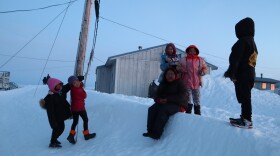The most dramatic storm in Alaska’s living memory slammed into the Bering Sea coast in September 2022. More than a year later, people in Hooper Bay, Chevak, and Newtok are still rebuilding.
But some of the most resilient residents, the children, are simply doing what they know best: "playing out," though they say that they have concerns about storms in the future.
“I’m worried about Hooper Bay breaking down,” said 12-year-old Esther Smith. She said that it’s fun to see the lightning and thunder when big storms roll through, but she really doesn’t like the wind.
“Last time I almost blowed away when I was going uptown to the store,” Smith said.
Hooper Bay lies right on the Bering Sea coast, and the only barrier between the village and the crashing ocean waves is a row of sand dunes that were severely damaged, and in some cases destroyed, last fall. Even so, kids here love spending time outside and they get pretty creative.
Like Charlene Hunter, who perched on a giant piece of insulating foam blown off a building. She used a piece of wood to paddle around a roadside puddle. She was joined by several of her friends.

“We kind of found our own stuffs,” the 14-year-old Hunter said.
As Hooper Bay’s newly founded armada paddled and splashed, 16-year-old Gloria Hunter played basketball about 50 yards away.

Gloria shot the ball toward a hoop that hung off the back wall of a large green building on the older side of the village. This is where floodwaters from Typhoon Merbok had some of the greatest impact.
“I was scared of it because I thought it would come to our houses and take it away,” Gloria said.
Twenty miles due east of Hooper Bay lies Chevak, an inland community. But when Typhoon Merbok arrived last year, Chevak could have been mistaken for a coastal village. The storm surge brought flood waters at least a dozen feet deep, inundating the tundra, overflowing the Ninglikfak River, and swamping most of the boats people use for subsistence fishing, hunting, and gathering. Many people also lost their fish camps.
For some of the kids who evacuated to Chevak’s school, like Kirsten Seaton Jones, it was an adventure.
“We do fun stuffs,” said the nine-year old Jones. “[We] play tag and hide and seek.”
She was joined by a friend, fourth-grader Anna Charles, who isn’t fazed by a bitter, cold wind or the bits of sharp, cheek-stinging snow. She said that she prefers to “play out,” what many here call playing outside.

The village of Newtok was also seriously impacted by Typhoon Merbok. The community was already struggling with the impacts of a changing climate before the record storm blew through. In the fall of 2022, it severely impacted the community’s remaining critical infrastructure and now there’s no place to evacuate if it happens again.
But after school on an overcast mid-November afternoon, that didn’t seem to be front of mind for a handful of kids who had chosen a frozen pond in the heart of the village as their playground.

“I like ice skating because it’s fun,” said nine-year-old Michaeline John. She found an old pair of skates at home.
Logan John couldn’t find a pair of skates, so he improvised. He’d get a running start and scoot around on his feet. Occasionally he dropped to his knees and went flying across the ice.

Typhoon Merbok left scars all over Western Alaska. Many people are still trying to rebuild houses, repair boats, and replace damaged fishing gear and lost subsistence foods. But out here on this pond and on this afternoon, the kids aren’t considering any of that. They’re just playing out like they always do.
This reporting was supported by a grant from the Center for Rural Strategies and Grist.












